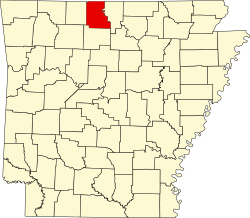Marion County, Arkansas | |
|---|---|
 Marion County Courthouse in Yellville | |
 Location within the U.S. state of Arkansas | |
| Coordinates: 36°16′47″N92°42′57″W / 36.279722222222°N 92.715833333333°W | |
| Country | |
| State | |
| Founded | September 25, 1836 |
| Named after | Francis Marion [1] |
| Seat | Yellville |
| Largest city | Bull Shoals |
| Area | |
• Total | 640 sq mi (1,700 km2) |
| • Land | 597 sq mi (1,550 km2) |
| • Water | 43 sq mi (110 km2) 6.8% |
| Population (2020) | |
• Total | 16,826 |
• Estimate (2024) | 17,593 |
| • Density | 28.2/sq mi (10.9/km2) |
| Time zone | UTC−6 (Central) |
| • Summer (DST) | UTC−5 (CDT) |
| Congressional district | 1st |
| Website | marioncounty |
Marion County (and Township) is located in the Ozark Mountains in the U.S. state of Arkansas. The county is named for Francis Marion, the famous "Swamp Fox" of the Revolutionary War. Created as Arkansas's 35th county in 1836, Marion County is home to one incorporated town and four incorporated cities, including Yellville, the county seat. The county is also the site of numerous unincorporated communities and ghost towns. The county included part of what is now Searcy County, Arkansas, with many opposing to dividing them, which helped fuel the bloody Tutt-Everett War between 1844 and 1850.
Contents
- History
- Geography
- Adjacent counties
- National protected areas
- Demographics
- 2020 census
- 2000 census
- Government
- Politics
- Taxation
- Communities
- Townships
- Cities
- Town
- Census-designated places
- Infrastructure
- Major highways
- Education
- See also
- References
- External links
Occupying 640 square miles (170,000 ha), the county's population was 16,826 as of the 2020 Census. [2] Based on population, the county ranks 42nd of the 75 in Arkansas. [3] In the Ozarks, the county is largely covered with rugged terrain and waterways, with the exception of King's Prairie in the southwestern portion. It is drained by the White River, Buffalo River, Crooked Creek, and the Little North Fork of White River. Protected areas of the county include Bull Shoals-White River State Park, Ozark National Forest, the Buffalo National River and four wildlife management areas (WMAs).
Although there are no Interstate highways in Marion County, two United States highways (U.S. Route 62 [US 62] and US 412) and eight Arkansas state highways run in the county. [4]

